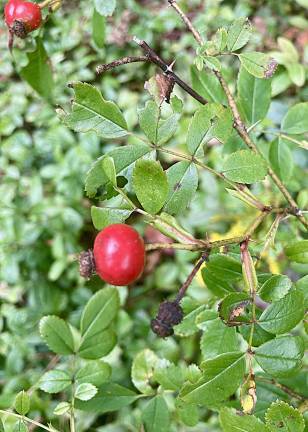Menace or medicine?

Take a stroll down a country lane or wander near a thicket and you’ll likely find her. Most folks scorn her. I’ve cursed her too. She’s domineering and has little respect for boundaries. But despite her prickly nature, invasive multiflora rose provides food and medicine.
Multiflora rose (Rosa multiflora) hails from Japan and was introduced to the United States in the mid 1800s. She was first appreciated as a rootstock for ornamental roses and later prized for erosion control, hedgerows and to attract wildlife. We have since recognized our folly. She quickly reclaims old fields and pastures, travels wooded trails, devours disturbed land and pals around with such notorious invasives as autumn olive, bittersweet and barberry. But please, just hear me out.
In autumn, multiflora rose is bejeweled with scarlet fruits. The fruit of multiflora rose contains tiny seeds packed into a waxy casing. That waxy casing, which we call the rosehip, is tart and flavorful, offering bright, lip-puckering goodness. And rosehips only grow tastier with a frost. Look for these tangy morsels well into winter dangling from well-armed woody canes.
Not only are rosehips delicious, but rich in vitamin C and a wealth of bioflavonoids, such as lycopene, rutin, quercetin, and catechin. Reach for a cup of rosehip tea to support the immune system and bolster cellular health. Their astringent nature can also tone tissue and reduce inflammation. Add rosehips to your bowl of steel-cut oats or morning smoothie. Pair them with orange zest or lavender in scones or muffins. They add a tangy flavor to any dish and brighten shortening days.
To harvest, simply pluck scarlet fruits from canes. Watch out for canes’ hooked prickles! Gather a pailful. At home, put on your favorite tunes – this is going to take a little while – slice open hips at center (like two halves of an egg), pinch out seeds with orangey hairs and discard. Reserve the waxy hips. Once you’ve got a heap, air dry or pop in the dehydrator for later use, blend fresh into recipes, or simply nibble for a sour snack.